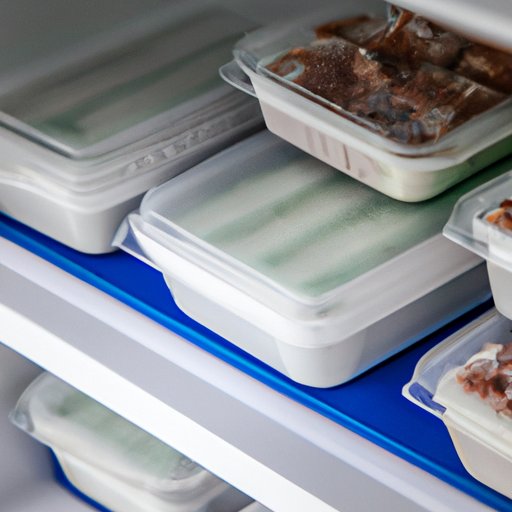
Introduction
If you’ve ever found yourself wondering whether or not it’s safe to put warm food in the fridge, you’re not alone. It’s a common question that many people have, and it’s an important one to answer correctly to avoid foodborne illnesses. In this article, we’ll explore the topic of refrigerating hot or warm dishes in depth, covering everything from how refrigeration works to the best storage practices. By the end, you’ll know exactly how to safely and effectively refrigerate hot dishes without worrying about food safety or quality concerns.
The Definitive Guide: Can You Put Warm Food in the Fridge?
Let’s start by addressing the question directly: can you put warm food in the fridge? The short answer is yes, you can, but it’s important to do so safely and effectively. The reason this question is so common is that there are some real risks associated with refrigerating hot food, but there are also benefits. Refrigeration can help prevent bacterial growth and keep dishes fresh for longer, but if not done properly, it can also impact the taste and quality of the food.
Hot or Not? The Science Behind Refrigerating Warm Food
To understand why and how to safely refrigerate warm or hot dishes, it’s important to understand how refrigeration works. Refrigerators work by removing heat from the air inside the fridge, which cools everything inside. When you place warm food inside the fridge, it can raise the temperature of the environment, which can impact the safety and quality of other items in the fridge.
When hot food is left out at room temperature, bacteria can start to grow rapidly. Refrigeration can help slow this growth, which is why it’s important to refrigerate potentially hazardous foods like poultry, meat, and dairy products. However, it’s crucial to avoid placing hot dishes directly into the fridge, as this can impact the safe temperature range of the surrounding food.
Fridge or Food Poisoning? Know the Risks and Benefits of Refrigerating Hot Dishes
While refrigeration can be a great tool for keeping food fresh and safe, there are some real risks to be aware of when it comes to refrigerating hot dishes. One of the biggest risks is the impact it can have on other food in the fridge. When hot food is placed in the fridge, it can cause the temperature to rise, which can lead to bacterial growth in other foods that are supposed to be kept at a lower temperature. To avoid this, it’s important to cool hot dishes down before placing them in the fridge.
Another risk associated with refrigerating hot dishes is that it can impact the texture and flavor of the food. Depending on the type of dish, refrigeration may cause it to dry out, become mushy, or lose its original flavor. This is why it’s important to consider whether refrigeration is necessary or if it’s better to store the dish in a different way, such as at room temperature or in the freezer.
5 Unexpected Reasons Why Refrigerating Warm Food Damages the Taste and Quality
Refrigerating hot or warm dishes can impact the taste and texture of the food in ways you may not expect. For instance, certain types of vegetables can become slimy or soggy when refrigerated, while bold spices can lose their flavor potency. To minimize these effects, it’s important to use the right storage containers and cooling methods. In this section, we’ll cover some of the most common ways refrigeration can impact the taste and quality of food, so you can be more mindful of these issues in your own kitchen.
‘Chill’ Out! Follow These Expert Tips on Storing Warm Leftovers to Keep Them Safe and Tasty
Storing warm leftovers can be a bit trickier than storing cold food, but with the right tools and methods, it can be done safely and effectively. In this section, we’ll cover some expert tips for storing warm leftovers, including the importance of using the right container and positioning within the fridge. We’ll also discuss how to reheat and serve refrigerated leftovers in a safe and appealing way.
The Ultimate Do’s and Don’ts: How to Refrigerate and Reheat Hot Dishes Safely
To ensure safe and effective refrigeration of hot dishes, there are some key do’s and don’ts you should keep in mind. In this section, we’ll summarize the most important tips and provide a checklist or step-by-step guide to follow for the best results. We’ll also address some common myths and misconceptions about refrigeration and reheating, so you can be sure to avoid these pitfalls in your own kitchen.
Food for Thought – The Impact of Refrigerating Hot Food on Your Energy Bill and the Environment
Refrigeration can have a big impact on your energy bill and the environment. By understanding how refrigeration works and how it impacts energy usage, you can make more informed decisions about your food storage practices. In this section, we’ll touch on some of the environmental impacts of refrigeration and provide suggestions for how to minimize this impact. We’ll also offer practical solutions for reducing energy usage in the kitchen more generally.
Conclusion
Refrigerating hot or warm dishes can be a bit tricky, but with the right tools and knowledge, it can be done safely and effectively. From the science behind refrigeration to the best storage practices and tips for minimizing the impact on taste and quality, this article has covered everything you need to know to feel confident in your ability to refrigerate hot dishes safely. By following these guidelines, you can keep your food fresh and safe for longer, minimize food waste, and help protect the environment.




